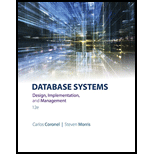
Explanation of Solution
Homonyms:
When more than one attributes have the same name, they are referred as “homonyms”.
It indicates the use of same name to label different attributes.
Example:
Suppose in table “STUDENT”, one of the attribute names is “student_number”. Also, in table “PROFESSOR”, there exists an attribute with name “student_number”. Then both the attributes are named as “Homonyms”.
Synonyms:
When more than one name is assigned to same attribute, the attribute names are referred as “synonyms’. It exists when the same attribute has more than one name.
Example:
Suppose in table STUDENT, one of the attribute names is “STU_NUM” which displays the student registration number. Also, another attribute is “STU_ID” which also displays the student registration number. Then the attribute names are named as “Synonyms”.
Homonyms and Synonyms in
The use of homonyms and synonyms should be avoided in database design. This is due to the following reason:
- To avoid inconsistency in the database design.
For example:
Suppose we check the database for a specific attribute such as “ID”. If “ID” refers to student ID as well as to professor’s ID, a clear case of a homonym, it is a creation of an ambiguity, because it is no longer clear which entity the “ID” belongs to...
Trending nowThis is a popular solution!

Chapter 3 Solutions
Database Systems: Design, Implementation, & Management
- Capsim Team PowerPoint Presentations - Slide Title: Key LearningsWhat were the key learnings that you discovered as a team through your Capsim simulation?arrow_forwardWrite the SQL code that permits to implement the tables: Student and Transcript. NB: Add the constraints on the attributes – keys and other.arrow_forwardDraw an ERD that will involve the entity types: Professor, Student, Department and Course. Be sure to add relationship types, key attributes, attributes and multiplicity on the ERD.arrow_forward
 Principles of Information Systems (MindTap Course...Computer ScienceISBN:9781305971776Author:Ralph Stair, George ReynoldsPublisher:Cengage Learning
Principles of Information Systems (MindTap Course...Computer ScienceISBN:9781305971776Author:Ralph Stair, George ReynoldsPublisher:Cengage Learning Database Systems: Design, Implementation, & Manag...Computer ScienceISBN:9781285196145Author:Steven, Steven Morris, Carlos Coronel, Carlos, Coronel, Carlos; Morris, Carlos Coronel and Steven Morris, Carlos Coronel; Steven Morris, Steven Morris; Carlos CoronelPublisher:Cengage Learning
Database Systems: Design, Implementation, & Manag...Computer ScienceISBN:9781285196145Author:Steven, Steven Morris, Carlos Coronel, Carlos, Coronel, Carlos; Morris, Carlos Coronel and Steven Morris, Carlos Coronel; Steven Morris, Steven Morris; Carlos CoronelPublisher:Cengage Learning Fundamentals of Information SystemsComputer ScienceISBN:9781337097536Author:Ralph Stair, George ReynoldsPublisher:Cengage Learning
Fundamentals of Information SystemsComputer ScienceISBN:9781337097536Author:Ralph Stair, George ReynoldsPublisher:Cengage Learning A Guide to SQLComputer ScienceISBN:9781111527273Author:Philip J. PrattPublisher:Course Technology Ptr
A Guide to SQLComputer ScienceISBN:9781111527273Author:Philip J. PrattPublisher:Course Technology Ptr
 Fundamentals of Information SystemsComputer ScienceISBN:9781305082168Author:Ralph Stair, George ReynoldsPublisher:Cengage Learning
Fundamentals of Information SystemsComputer ScienceISBN:9781305082168Author:Ralph Stair, George ReynoldsPublisher:Cengage Learning





